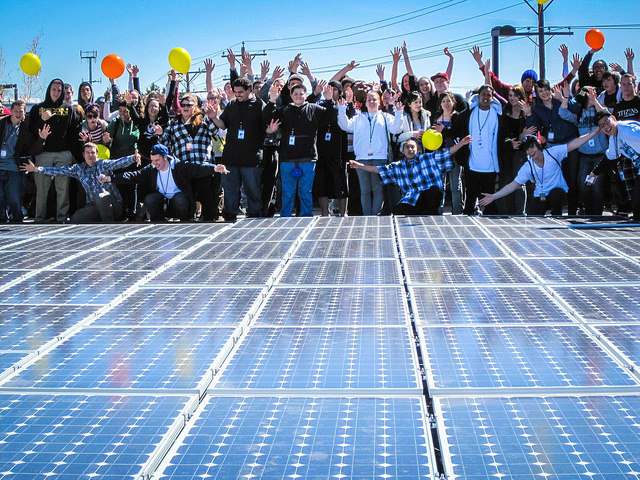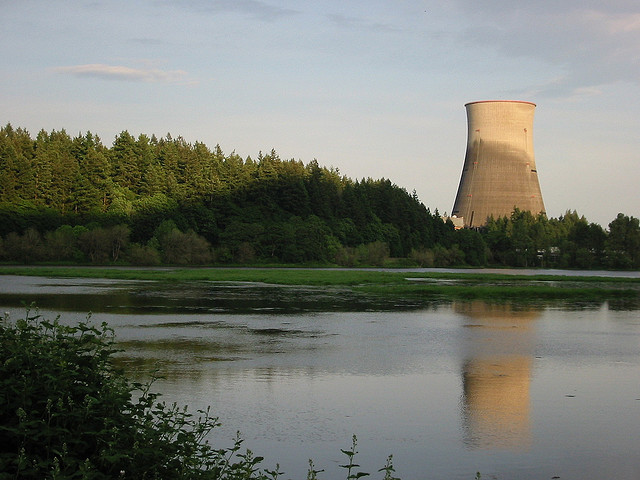I spent three days this week with some of the biggest minds behind the “new economy” movement because their core theme – economic democracy – fits like a glove over ILSR’s work on democratic energy.
The big takeaway? Solar power is the spark to energize a new energy economy from the bottom up.
This new solar-sparked energy system will look entirely different from the old energy economy, because the technology to meet the energy needs of the 20th century are fundamentally different from those needed to meet the needs of the 21st century.
Building out the original electric grid in the early 1900s was a monumental task, requiring vast amounts of capital to finance poles, wires, and power plants. Since we only needed one electric grid, and since government saw electricity as a luxury at the time, it led to a market dominated by first natural and then regulated, corporate monopolies. Without competition, it was easier to finance grid infrastructure and to build ever-larger power plants to serve endlessly increasing demand.
For the first 50 years or so, this arrangement served the public and private interests, driving down the cost of electricity and expanding access.* But beginning with the Energy Crisis in the 1970s, the public and private interests in the electricity system have steadily diverged. Utility companies continued to pursue more and more electricity sales even as efficiency became a clear least cost supply. Utilities kept building fossil fuel power plants even as it became clear that wind and solar power could dramatically shrink the environmental footprint of electricity generation at competitive cost. Finally, utilities have fiercely defended their market turf, even as customer ownership of small-scale power generation has proven that communities no longer need a private utility to manage all of their energy dollars.
Solar power is the catalyst for the new energy economy because customers can for the first time cost-effectively supply electricity from their own home or business. Solar provides more utility than energy efficiency, which is limited to reducing energy consumption (even if it is the lowest cost resource). Solar provides more opportunity than large-scale renewable energy, which can at best reduce pollution and wholesale energy costs. Decentralized solar is democratic because it provides both political and economic power by allowing people, individually and collectively, to challenge the utility monopoly over energy supply.
For the first time in forever (sorry, parent of young kids here), solar offers communities a chance to reverse the flow of energy dollars out of their community. Every megawatt of solar installed adds $2.5 million and 20 construction jobs to the local economy. In its 25-year lifetime, a locally owned solar project will redirect an additional $5.4 million of electricity spending back into local pockets. With new (crowd financed and maintenance free) solar loans, solar ownership is getting easier than ever. And with expanding opportunities for community solar projects, solar is increasingly available to the 75% of Americans who don’t own a sunny rooftop.
Despite solar’s small size (the individual panels are often just 200-300 Watts each), its cumulative impact is very large. In 2013, for example, rooftop solar power on homes represented 7% of all new power generation in the United States. In Germany, 80% or more of the 36,000 megawatts of solar energy is supplied by projects 100 kilowatts and smaller, each less than the size of grocery store roof.
Decentralized, rooftop solar could provide enormous amounts of electricity, 15% or more of total electricity sales in most states.
It’s not just electrons, but competitive pricing that makes solar attractive. By 2022, 312,000 megawatts of solar could be installed across the United States at prices competitive with utility retail rates. It could be higher, but this conservative estimate limits solar to 20% of each utility’s total sales.
Altogether, this 312,000 megawatts of cost-competitive, unsubsidized solar would supply over 9% of total electricity sales in the United States, redirecting nearly $33 billion in electricity spending back into local communities.
Solar isn’t just energy for the economy, but it provides power for the people. And while solar energy systems may derive their energy from the top down (sunshine), decentralized solar power promises to build a new energy economy from the ground up.
*Note: at least to urban areas. It took federal intervention via the Rural Electrification Administration to get electricity to farms and rural communities.
This article originally posted at ilsr.org. For timely updates, follow John Farrell on Twitter or get the Democratic Energy weekly update.
Photo credit: Daniel Schroeder







